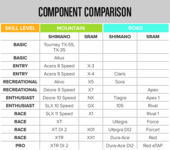It would be better if you bought it from your local bike shop because (at least in my experience) they are a lot nicer/more accommodating with my requests when I purchase it from them directly (and they don’t charge me for many low cost adjustments/corrections) the first 6 months of ownership. As far as comparing them, they all have many of the same components. I believe the main differences of the CrossCore is that it has lower grade “recreational” (Sora) Shimano shifters (9-speed, single chain), derailleurs and mechanical (not hydraulic) disc brakes. And, of course, it has a more upright seating position for comfort. The Urban Rush and the Civante have a better “enthusiast” grade Shimano set called Tiagra. The main difference between these two is that the Civante’s motor supports the rider up to 28 miles per hour (the Urban Rush stops at 20mph). Because the Civante has 2 freewheels, there is no resistance/drag when you reach the motor support limit of 28mph. It rides like a regular bike. The Civantes computer firmware has been programmed to allow the motor to provide riders with enough motor support for them to achieve 28mph as long as they have a 100 cadence in any gear. If you plan on using the bike with road cyclists, the Civante would allow you to keep up and climb steep 3,800ft elevation hills. In my experience, the Civante has a battery range of 57 miles (avg speed of 15mph) using the two highest settings on a 4-hr bike ride with 3,800ft elevation gain. The range is longer using the two lowest settings. If you’re riding the bike mainly for slower (less than 20mph) recreational purposes, the CrossConnect is more comfortable. And, it’s $1,000 cheaper!! In my opinion, only the Civante is worth the extra $1,000 because of the 28mph motor, double chainring, 2 freewheels (for peddling without turning the motor) and the Tiagra group set. The 2nd cheapest class 3 road bike with drop handlebars, a minimum of 70nm of torque and 500w battery (from a major bike manufacturer) with better specs costs $4,700 from Giant. The 3rd cheapest is the Trek for $7,000. Giant and Trek don’t offer class 3 “drop handlebar” road bikes without the more expensive Ultregra components. I wouldn’t pay an extra $1,000 over the CrossConnect for the UrbanRush (IMHO). I’m not sure why anyone would buy the Urban Rush instead of the Civante. The Civante was released July/August of 2020 so people who wanted a drop bar road bike with a double chain ring could only buy the Urban Rush before the Civante was released. The Wabash has a drop bar but it only has a single chain ring so it’s mainly good on speeds less than 20mph and is also limited on steep climbs because of the single chainring but it is great for off road cycling at lower speeds. I just got my Civante a couple of weeks ago so feel free to ask me any questions.
Main difference between the Bosch motor (not sure if this applies to the 4th gen motors) and Yamaha:
Yamaha Zero cadence support with 2 freewheels
Most mid-drive motors (like the Bosch) have just one freewheel, this is used for pedaling without turning the motor. With just a single freewheel, the motor can never drive the rear wheel without the pedals turning, this requires an extra freewheel.
The Yamaha has 2 freewheels, so we can do both:
- Pedaling without turning the motor
- The motor can drive the rear wheel without the pedals turning

